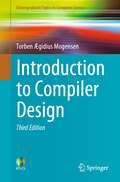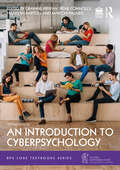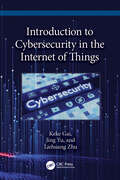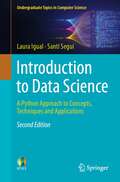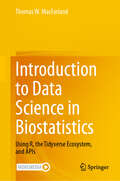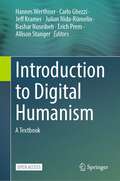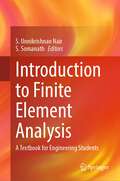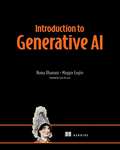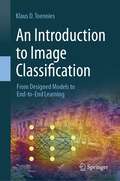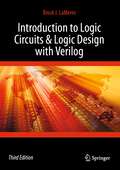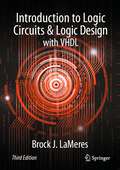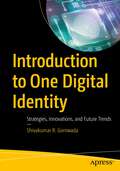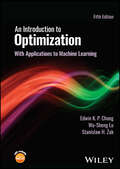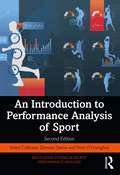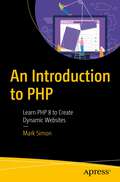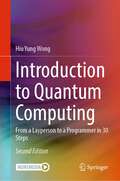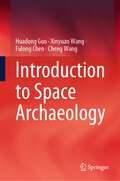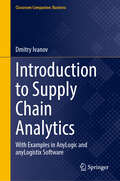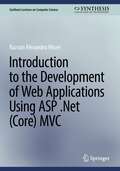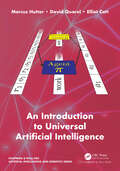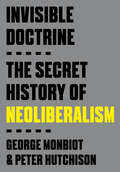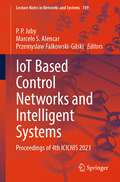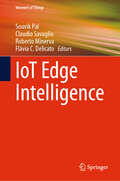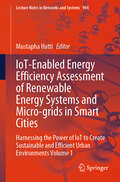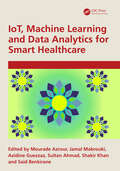- Table View
- List View
Introduction to Compiler Design (Undergraduate Topics in Computer Science)
by Torben Ægidius MogensenThe third edition of this textbook has been fully revised and adds material about the SSA form, polymorphism, garbage collection, and pattern matching. It presents techniques for making realistic compilers for simple to intermediate-complexity programming languages. The techniques presented in the book are close to those used in professional compilers, albeit in places slightly simplified for presentation purposes. "Further reading" sections point to material about the full versions of the techniques.All phases required for translating a high-level language to symbolic machine language are covered, and some techniques for optimising code are presented. Type checking and interpretation are also included.Aiming to be neutral with respect to implementation languages, algorithms are mostly presented in pseudo code rather than in any specific language, but suggestions are in many places given for how these can be realised in different language paradigms.Depending on how much of the material from the book is used, it is suitable for both undergraduate and graduate courses for introducing compiler design and implementation.
An Introduction to Cyberpsychology (BPS Core Textbooks Series)
by Gráinne Kirwan, Irene Connolly, Hannah Barton, and Marion PalmerAn Introduction to Cyberpsychology provides a comprehensive introduction to this rapidly growing discipline. Fully updated in its second edition, the book encourages students to critically evaluate the psychology of online interactions and to develop appropriate research methodologies to complete their own work in this field.The book examines cyberpsychology and online research methodologies, social psychology in an online context, practical applications of cyberpsychology, and the psychological aspects of other technologies. This new edition has been carefully updated to include additional coverage of: Expanded content relating to major developments in the field and new content on gaming and screentime A new chapter examining the relationship between older adults and technology Cyberpsychology in focus feature boxes in each chapter that examine topics in depth Interviews with professionals working in fields relating to cyberpsychology Each chapter includes key terms and a glossary, content summaries, discussion questions, and recommended reading to guide further study.Supported by extensive online resources for students and instructors, this authoritative book is an essential core text for undergraduate modules in cyberpsychology, and an ideal primer for students of postgraduate programs in cyberpsychology.To view the additional student and instructor resources for this book, please visit bpscoretextbooks.routledge.com
Introduction to Cybersecurity in the Internet of Things
by Keke Gai Jing Yu Liehuang ZhuThis book addresses the security challenges facing the rapidly growing Internet of Things (IoT) industry, including the potential threats and risks arising from its complex architecture.The authors discuss the overall IoT architecture, covering networking, computing, and security threats and risks to hardware such as sensors, actuators, and portable devices, as well as infrastructure layers. They cover a range of technical concepts such as cryptography, distributed storage, and data transmission, and offer practical advice on implementing security solutions such as authentication and access control.By exploring the future of cybersecurity in the IoT industry, with insights into the importance of big data and the threats posed by data mining techniques, this book is an essential resource for anyone interested in, or working in, the rapidly evolving field of IoT security.
Introduction to Data Science: A Python Approach to Concepts, Techniques and Applications (Undergraduate Topics in Computer Science)
by Laura Igual Santi SeguíThis accessible and classroom-tested textbook/reference presents an introduction to the fundamentals of the interdisciplinary field of data science. The coverage spans key concepts from statistics, machine/deep learning and responsible data science, useful techniques for network analysis and natural language processing, and practical applications of data science such as recommender systems or sentiment analysis. Topics and features: Provides numerous practical case studies using real-world data throughout the book Supports understanding through hands-on experience of solving data science problems using Python Describes concepts, techniques and tools for statistical analysis, machine learning, graph analysis, natural language processing, deep learning and responsible data scienceReviews a range of applications of data science, including recommender systems and sentiment analysis of text data Provides supplementary code resources and data at an associated website This practically-focused textbook provides an ideal introduction to the field for upper-tier undergraduate and beginning graduate students from computer science, mathematics, statistics, and other technical disciplines. The work is also eminently suitable for professionals on continuous education short courses, and to researchers following self-study courses.
Introduction to Data Science in Biostatistics: Using R, the Tidyverse Ecosystem, and APIs
by Thomas W. MacFarlandIntroduction to Data Science in Biostatistics: Using R, the Tidyverse Ecosystem, and APIs defines and explores the term "data science" and discusses the many professional skills and competencies affiliated with the industry. With data science being a leading indicator of interest in STEM fields, the text also investigates this ongoing growth of demand in these spaces, with the goal of providing readers who are entering the professional world with foundational knowledge of required skills, job trends, and salary expectations. The text provides a historical overview of computing and the field's progression to R as it exists today, including the multitude of packages and functions associated with both Base R and the tidyverse ecosystem. Readers will learn how to use R to work with real data, as well as how to communicate results to external stakeholders. A distinguishing feature of this text is its emphasis on the emerging use of APIs to obtain data.
Introduction to Digital Humanism: A Textbook
by Hannes Werthner Carlo Ghezzi Jeff Kramer Julian Nida-Rümelin Bashar Nuseibeh Erich Prem Allison StangerThis open access textbook introduces and defines digital humanism from a diverse range of disciplines. Following the 2019 Vienna Manifesto, the book calls for a digital humanism that describes, analyzes, and, most importantly, influences the complex interplay of technology and humankind, for a better society and life, fully respecting universal human rights. The book is organized in three parts: Part I “Background” provides the multidisciplinary background needed to understand digital humanism in its philosophical, cultural, technological, historical, social, and economic dimensions. The goal is to present the necessary knowledge upon which an effective interdisciplinary discourse on digital humanism can be founded. Part II “Digital Humanism – a System’s View” focuses on an in-depth presentation and discussion of the main digital humanism concerns arising in current digital systems. The goal of this part is to make readers aware and sensitive to these issues, including e.g. the control and autonomy of AI systems, privacy and security, and the role of governance. Part III “Critical and Societal Issues of Digital Systems” delves into critical societal issues raised by advances of digital technologies. While the public debate in the past has often focused on them separately, especially when they became visible through sensational events the aim here is to shed light on the entire landscape and show their interconnected relationships. This includes issues such as AI and ethics, fairness and bias, privacy and surveillance, platform power and democracy. This textbook is intended for students, teachers, and policy makers interested in digital humanism. It is designed for stand-alone and for complementary courses in computer science, or curricula in science, engineering, humanities and social sciences. Each chapter includes questions for students and an annotated reading list to dive deeper into the associated chapter material. The book aims to provide readers with as wide an exposure as possible to digital advances and their consequences for humanity. It includes constructive ideas and approaches that seek to ensure that our collective digital future is determined through human agency.
Introduction to Finite Element Analysis: A Textbook for Engineering Students
by S. Unnikrishnan Nair S. SomanathThis textbook covers the basic concepts and applications of finite element analysis. It is specifically aimed at introducing this advanced topic to undergraduate-level engineering students and practicing engineers in a lucid manner. It also introduces a structural and heat transfer analysis software FEASTSMT which has wide applications in civil, mechanical, nuclear and automobile engineering domains. This software has been developed by generations of scientists and engineers of Vikram Sarabhai Space Centre and Indian Space Research Organisation. Supported with many illustrative examples, the textbook covers the classical methods of estimating solutions of mathematical models. The book is written in an easy-to-understand manner. This textbook also contains numeral exercise problems to aid self-learning of the students. The solutions to these problems are demonstrated using finite element software. Furthermore, the textbook contains several tutorials and associated online resources on usage of the FEASTSMT software. Given the contents, this textbook is highly useful for the undergraduate students of various disciplines of engineering. It is also a good reference book for the practicing engineers.
Introduction to Generative AI
by Numa DhamaniGenerative AI tools like ChatGPT are amazing—but how will their use impact our society? This book introduces the world-transforming technology and the strategies you need to use generative AI safely and effectively.Introduction to Generative AI gives you the hows-and-whys of generative AI in accessible language. In this easy-to-read introduction, you&’ll learn: How large language models (LLMs) work How to integrate generative AI into your personal and professional workflows Balancing innovation and responsibility The social, legal, and policy landscape around generative AI Societal impacts of generative AI Where AI is going Anyone who uses ChatGPT for even a few minutes can tell that it&’s truly different from other chatbots or question-and-answer tools. Introduction to Generative AI guides you from that first eye-opening interaction to how these powerful tools can transform your personal and professional life. In it, you&’ll get no-nonsense guidance on generative AI fundamentals to help you understand what these models are (and aren&’t) capable of, and how you can use them to your greatest advantage. Foreword by Sahar Massachi. About the technology Generative AI tools like ChatGPT, Bing, and Bard have permanently transformed the way we work, learn, and communicate. This delightful book shows you exactly how Generative AI works in plain, jargon-free English, along with the insights you&’ll need to use it safely and effectively. About the book Introduction to Generative AI guides you through benefits, risks, and limitations of Generative AI technology. You&’ll discover how AI models learn and think, explore best practices for creating text and graphics, and consider the impact of AI on society, the economy, and the law. Along the way, you&’ll practice strategies for getting accurate responses and even understand how to handle misuse and security threats. What's inside How large language models work Integrate Generative AI into your daily work Balance innovation and responsibility About the reader For anyone interested in Generative AI. No technical experience required. About the author Numa Dhamani is a natural language processing expert working at the intersection of technology and society. Maggie Engler is an engineer and researcher currently working on safety for large language models. The technical editor on this book was Maris Sekar. Table of Contents 1 Large language models: The power of AI Evolution of natural language processing 2 Training large language models 3 Data privacy and safety with LLMs 4 The evolution of created content 5 Misuse and adversarial attacks 6 Accelerating productivity: Machine-augmented work 7 Making social connections with chatbots 8 What&’s next for AI and LLMs 9 Broadening the horizon: Exploratory topics in AI
An Introduction to Image Classification: From Designed Models to End-to-End Learning
by Klaus D. ToenniesImage classification is a critical component in computer vision tasks and has numerous applications. Traditional methods for image classification involve feature extraction and classification in feature space. Current state-of-the-art methods utilize end-to-end learning with deep neural networks, where feature extraction and classification are integrated into the model. Understanding traditional image classification is important because many of its design concepts directly correspond to components of a neural network. This knowledge can help demystify the behavior of these networks, which may seem opaque at first sight. The book starts from introducing methods for model-driven feature extraction and classification, including basic computer vision techniques for extracting high-level semantics from images. A brief overview of probabilistic classification with generative and discriminative classifiers is then provided. Next, neural networks are presented as a means to learn a classification model directly from labeled sample images, with individual components of the network discussed. The relationships between network components and those of a traditional designed model are explored, and different concepts for regularizing model training are explained. Finally, various methods for analyzing what a network has learned are covered in the closing section of the book. The topic of image classification is presented as a thoroughly curated sequence of steps that gradually increase understanding of the working of a fully trainable classifier. Practical exercises in Python/Keras/Tensorflow have been designed to allow for experimental exploration of these concepts. In each chapter, suitable functions from Python modules are briefly introduced to provide students with the necessary tools to conduct these experiments.
Introduction to Logic Circuits & Logic Design with Verilog
by Brock J. LaMeresThis textbook for courses in Digital Systems Design introduces students to the fundamental hardware used in modern computers. Coverage includes both the classical approach to digital system design (i.e., pen and paper) in addition to the modern hardware description language (HDL) design approach (computer-based). Using this textbook enables readers to design digital systems using the modern HDL approach, but they have a broad foundation of knowledge of the underlying hardware and theory of their designs. This book is designed to match the way the material is actually taught in the classroom. Topics are presented in a manner which builds foundational knowledge before moving onto advanced topics. The author has designed the presentation with learning goals and assessment at its core. Each section addresses a specific learning outcome that the student should be able to “do” after its completion. The concept checks and exercise problems provide a rich set of assessment tools to measure student performance on each outcome.
Introduction to Logic Circuits & Logic Design with VHDL
by Brock J. LaMeresThis textbook introduces readers to the fundamental hardware used in modern computers. The only pre-requisite is algebra, so it can be taken by college freshman or sophomore students or even used in Advanced Placement courses in high school. This book presents both the classical approach to digital system design (i.e., pen and paper) in addition to the modern hardware description language (HDL) design approach (computer-based). This textbook enables readers to design digital systems using the modern HDL approach while ensuring they have a solid foundation of knowledge of the underlying hardware and theory of their designs. This book is designed to match the way the material is actually taught in the classroom. Topics are presented in a manner which builds foundational knowledge before moving onto advanced topics. The author has designed the content with learning goals and assessment at its core. Each section addresses a specific learning outcome that the learner should be able to “do” after its completion. The concept checks and exercise problems provide a rich set of assessment tools to measure learner performance on each outcome. This book can be used for either a sequence of two courses consisting of an introduction to logic circuits (Chapters 1-7) followed by logic design (Chapters 8-14) or a single, accelerated course that uses the early chapters as reference material.
Introduction to One Digital Identity: Strategies, Innovations, and Future Trends
by Shivakumar R. GoniwadaExplore the dynamics of digital identity, a crucial component in today’s modern technology-driven era. This engaging book offers a deep understanding of how digital identity is evolving rapidly, why it’s so significant, and offers organizations, regulatory bodies, and academicians the strategies needed to adopt secure decentralized digital identity features effectively. It’s a must-read for those aiming to grasp the intricacies of digital identity and leverage it for future innovation and security.The book begins by redefining digital identity, examining its evolution and the profound impact it has on both individuals and organizations. It then delves into the development of digital identity strategies, laying the foundation for future digital transformations. Covering a wide range of topics, the book discusses the innovation, challenges, and technological exploration in digital identity. A special focus is given to biometric technologies and the implementation of decentralized digital identities, addressing critical areas such as identity governance, blockchain, AI and advanced biometrics. The book also investigates the implications of digital identity across various industries, including cross border travel, healthcare, social media, finance, metaverse, IoT etc. finally the book provides not only emerging trends but offers a glimpse into the future digital identity. Whether you’re a tech professional, business leader, student or simply keen on understanding the impact of digital advancements, this book promises to offer insightful perspectives and practical solutions for navigating the complex world of digital identity. It underscores the importance of identity in spearheading digital innovation, making it a key resource for anyone looking to stay ahead in the digital landscape. As you reach its conclusion, you’ll be equipped with a wealth of knowledge and insights that are crucial in today’s digital era.What You'll LearnDigital identity strategies and their role in shaping the future of digital identityDifferent facets of digital identitySpecifics of biometric technologies and decentralized digital identity Industry specific digital identity and its implementationCrucial aspects of privacy, ethics, and secure in the context of digital identityWho This Book Is ForSoftware professionals, security practitioners, architects, senior managers, executives, and students who are interested in digital identity.
An Introduction to Optimization: With Applications to Machine Learning (Wiley Series In Discrete Mathematics And Optimization Ser. #77)
by Edwin K. Chong Wu-Sheng Lu Stanislaw H. ŻakAn Introduction to Optimization Accessible introductory textbook on optimization theory and methods, with an emphasis on engineering design, featuring MATLAB® exercises and worked examples Fully updated to reflect modern developments in the field, the Fifth Edition of An Introduction to Optimization fills the need for an accessible, yet rigorous, introduction to optimization theory and methods, featuring innovative coverage and a straightforward approach. The book begins with a review of basic definitions and notations while also providing the related fundamental background of linear algebra, geometry, and calculus. With this foundation, the authors explore the essential topics of unconstrained optimization problems, linear programming problems, and nonlinear constrained optimization. In addition, the book includes an introduction to artificial neural networks, convex optimization, multi-objective optimization, and applications of optimization in machine learning. Numerous diagrams and figures found throughout the book complement the written presentation of key concepts, and each chapter is followed by MATLAB® exercises and practice problems that reinforce the discussed theory and algorithms. The Fifth Edition features a new chapter on Lagrangian (nonlinear) duality, expanded coverage on matrix games, projected gradient algorithms, machine learning, and numerous new exercises at the end of each chapter. An Introduction to Optimization includes information on: The mathematical definitions, notations, and relations from linear algebra, geometry, and calculus used in optimization Optimization algorithms, covering one-dimensional search, randomized search, and gradient, Newton, conjugate direction, and quasi-Newton methods Linear programming methods, covering the simplex algorithm, interior point methods, and duality Nonlinear constrained optimization, covering theory and algorithms, convex optimization, and Lagrangian duality Applications of optimization in machine learning, including neural network training, classification, stochastic gradient descent, linear regression, logistic regression, support vector machines, and clustering. An Introduction to Optimization is an ideal textbook for a one- or two-semester senior undergraduate or beginning graduate course in optimization theory and methods. The text is also of value for researchers and professionals in mathematics, operations research, electrical engineering, economics, statistics, and business.
An Introduction to Performance Analysis of Sport (Routledge Studies in Sports Performance Analysis)
by Adam Cullinane Gemma Davies Peter O'DonoghuePerformance analysis has become an essential tool for coaches, athletes, sports organisations and academic researchers. Collecting and interpreting performance data enables coaches to improve their training programmes, athletes to make better tactical decisions, sports organisations to manage teams more effectively and researchers to develop a better understanding of sports performance. This fully revised new edition is an essential introduction to the fundamental principles of performance analysis of sport and how to develop and operate performance analysis systems.Containing worked examples from real sporting events as well as new content examining innovations in determining what to analyse, advances in feedback technology, performance profiles, principles for delivering feedback and telestration within video sequences, An Introduction to Performance Analysis of Sport reviews the different types of data and information that performance analysis can generate and explains how to test for reliability.This cutting-edge book presents a step-by-step guide to developing both manual and computerised analysis systems and writing up and presenting findings from performance analysis programmes. Representing the most up-to-date, concise and engaging introduction to sports performance analysis, this book is an ideal course text for all introductory performance analysis courses, as well as an invaluable primer for coaches and practitioners in sport.
An Introduction to PHP: Learn PHP 8 to Create Dynamic Websites
by Mark SimonUse PHP to enhance your web pages. This book shows you how PHP programming works, and how to write and organize PHP code. The book starts with steps to download and install a setup for a sample website that will form the basis for upcoming chapters. You start by writing PHP code and learn how to mix it with HTML and manage the code. From there, you will learn about dynamic content, along with a deep dive into form processing and sending email. Saving uploaded data and uploading files is discussed next. You will learn how to configure your PHP project and develop a library. You will then learn how to create an image catalog and manage data on your web page. By the end of the book, you will understand how to work with cookies, sessions, and logging in, followed by an example of creating a simple blog that reiterates the concepts developed in the previous chapters.After reading this book, you will be able to configure, create, and manage your dynamic website.What Will You LearnKnow the basics of programming with the PHP languageUse PHP to generate dynamic web pagesWork with SQL databasesWork with forms to upload text data and binary filesUse tips and tricks to write clean and maintainable codeWho This Book Is ForWeb developers and students learning to develop and maintain PHP code on their website
Introduction to Quantum Computing: From a Layperson to a Programmer in 30 Steps
by Hiu Yung WongThis textbook introduces quantum computing to readers who do not have much background in linear algebra based on the self-study experience of the author as an engineer. The author targets undergraduate and master students who are willing to spend about 60 -90 hours seriously learning quantum computing. This book is also suitable for self-study and teaching videos for each chapter and more than 200 exercises with answers are provided. Readers will be able to write their program to simulate quantum computing algorithms and run on real quantum computers on IBM-Q. Moreover, unlike books that only give superficial, “hand-waving” explanations, this book uses exact formalism so readers can continue to pursue more advanced topics based on what they learn from this book
Introduction to Space Archaeology
by Huadong Guo Xinyuan Wang Fulong Chen Cheng WangThis book presents the basic principles and the latest advances in space archaeology. Following general reviews of the state of the art of Earth observation technologies and archaeology, the book introduces the principles and methods of space archaeology, remote sensing methods for archaeological survey, and integrated archaeological survey methods including geophysics, virtual reality, web technologies, global positioning systems (GPS), geographical information systems (GIS), and big data. The book then presents two chapters on case studies of word heritage sites in Asia, Europe, Africa, and Americas, including three major world heritage sites in China: The Great Wall, Grand Canal, and Silk Road. The last chapter of the book discusses the future of space archaeology. This book has an interdisciplinary appeal and scholars with an interest in cultural heritage and remote sensing technologies for Earth value its contribution.
Introduction to Supply Chain Analytics: With Examples in AnyLogic and anyLogistix Software (Classroom Companion: Business)
by Dmitry IvanovThe book offers a concise yet comprehensive introduction to supply chain analytics covering management, modeling, and technology perspectives. Designed to accompany the textbook “Global Supply Chain and Operations Management”, it addresses the topics of supply chain analytics in more depth. The book describes descriptive, predictive, and prescriptive supply chain analytics explaining methodologies, illustrating method applications with the use of training exercises, and providing numerous examples in AnyLogic and anyLogistix software. Throughout the book, numerous practical examples and short case studies are given to illustrate theoretical concepts. Along with AnyLogic and anyLogistix model development guidelines and examples, the book has two other distinct features. First, it reviews and explains novel frameworks and concepts related to data-driven decision-making and digital twins. Second, it shows how to use analytics to improve supply chain resilience.Without relying heavily on mathematical derivations, the book offers a structured presentation and explanation of major supply chain analytics techniques and principles in a simple, predictable format to make it easy to understand for students and professionals with both management and engineering backgrounds. Graduate/Ph.D. students and supply chain professionals alike would benefit from a structured and didactically-oriented concise presentation of the concepts, principles, and methods of supply chain analytics. Providing graduate students and supply chain managers with working knowledge of basic and advanced supply chain analytics, this book contributes to improving knowledge-awareness of decision-making in increasingly data-driven and digital environments. The book is supplemented by a companion website offering interactive exercises with the use of AnyLogic and anyLogistix software as well as Spreadsheet Modeling.
Introduction to the Development of Web Applications Using ASP .Net (Synthesis Lectures on Computer Science)
by Razvan Alexandru MezeiThis book introduces a simplified approach to web application development using the open-source ASP .Net Core MVC framework. Readers will learn to implement web applications using the following languages and frameworks: HTML, JavaScript, CSS, Bootstrap, C#, ASP .Net, and Entity Framework Core. In addition, this book addresses how to build a web application to create user accounts, store data in a database, manipulate data, and how to allow controlled access to certain parts of the application functionality. The author also covers both client-side and server-side development and the use of an object relational mapper to work with persistent data (using a database). Topics include: models, views, controllers, routing, entity framework core, identity, layouts, dependency injection and services, model binder, among others. This book: Introduces the development of web applications using the open-source ASP .Net Core MVC frameworkImplements web applications including HTML, JavaScript, CSS, Bootstrap, C#, ASP .Net, and Entity Framework CoreFeatures client-side development, server-side development, and object relational mapper software
An Introduction to Universal Artificial Intelligence (Chapman & Hall/CRC Artificial Intelligence and Robotics Series)
by Marcus Hutter David Quarel Elliot CattAn Introduction to Universal Artificial Intelligence provides the formal underpinning of what it means for an agent to act intelligently in an unknown environment. First presented in Universal Algorithmic Intelligence (Hutter, 2000), UAI offers a framework in which virtually all AI problems can be formulated, and a theory of how to solve them. UAI unifies ideas from sequential decision theory, Bayesian inference, and algorithmic information theory to construct AIXI, an optimal reinforcement learning agent that learns to act optimally in unknown environments. AIXI is the theoretical gold standard for intelligent behavior.The book covers both the theoretical and practical aspects of UAI. Bayesian updating can be done efficiently with context tree weighting, and planning can be approximated by sampling with Monte Carlo tree search. It provides algorithms for the reader to implement, and experimental results to compare against. These algorithms are used to approximate AIXI. The book ends with a philosophical discussion of Artificial General Intelligence: Can super-intelligent agents even be constructed? Is it inevitable that they will be constructed, and what are the potential consequences?This text is suitable for late undergraduate students. It provides an extensive chapter to fill in the required mathematics, probability, information, and computability theory background.
Invisible Doctrine: The Secret History of Neoliberalism
by George Monbiot Peter HutchisonWe live under an ideology that preys on every aspect of our lives: our education and our jobs; our healthcare and our leisure; our relationships and our mental well-being; the planet we inhabit—the very air we breathe. It is everywhere. Yet for most people, it has no name. It seems inescapable, like a natural law.But trace it back to its roots, and you see that this ideology is neither inevitable nor immutable. It was conceived and propagated—and then concealed—by the powerful few. Our task is to bring it into the light—and to build a new system that is worth fighting for. Neoliberalism.Do you know what it is?
IoT Based Control Networks and Intelligent Systems: Proceedings of 4th ICICNIS 2023 (Lecture Notes in Networks and Systems #789)
by P. P. Joby Marcelo S. Alencar Przemyslaw Falkowski-GilskiThis book gathers selected papers presented at International Conference on IoT Based Control Networks and Intelligent Systems (ICICNIS 2023), organized by School of Computer Science and Engineering, REVA University, Bengaluru, India, during June 21–22, 2023. The book covers state-of-the-art research insights on Internet of things (IoT) paradigm to access, manage, and control the objects/things/people working under various information systems and deployed under wide range of applications like smart cities, healthcare, industries, and smart homes.
IoT Edge Intelligence (Internet of Things)
by Flávia C. Delicato Roberto Minerva Souvik Pal Claudio SavaglioThis book explores fundamental and advanced concepts related to the AI-enabled Edge Technology paradigm, also known as Edge Intelligence, within the framework of the Internet of Things (IoT). Expanding the application of Edge computing is increasingly necessary. This can involve exploring automated, intelligent computational learning theorems, and ANN-oriented, trustworthy machine learning perspectives to enhance computational intelligence. The book functions as a valuable resource for professionals in the sector and also acts as a comprehensive learning tool for newcomers in the field of AI-enabled Edge Technologies and their applications, covering both fundamental and advanced concepts. This book uses data and network engineering and intelligent decision support system-by-design principles to design a reliable IoT edge-cloud ecosystem and to implement cyber-physical pervasive infrastructure solutions. The book will help readers understand the design architecture and AI algorithms and learn analytics through IoT edge, device-edge and the state-of-the-art in cloud-IoT countermeasures. The book is a valuable reference for anyone doing undergraduate or postgraduate studies, conducting research, or working in the computer science, information technology, electronics engineering, and complicated mathematical modeling domains.
IoT-Enabled Energy Efficiency Assessment of Renewable Energy Systems and Micro-grids in Smart Cities: Harnessing the Power of IoT to Create Sustainable and Efficient Urban Environments Volume 1 (Lecture Notes in Networks and Systems #984)
by Mustapha HattiThis book embarks on a transformative exploration of sustainable urban development, integrating Internet of Things (IoT) technologies in energy efficiency assessments of renewable energy systems and microgrids within smart cities. This work transcends conventional approaches, seamlessly blending theoretical insights with practical applications, and prioritizing real-time, IoT-enabled assessments for optimal energy utilization. Evolving the understanding of renewable energy systems and microgrids, the book distinguishes itself through its hands-on application of IoT technologies. It not only delves into theoretical aspects but also equips readers with actionable insights, guiding the implementation of IoT for informed decision-making in the dynamic landscape of smart city environments. From IoT sensor deployment strategies to data analytics techniques and practical considerations, the book's expansive scope offers a comprehensive roadmap for creating resilient and efficient energy ecosystems. Tailored for professionals, researchers, and policymakers in energy management, urban planning, and IoT technology, this resource speaks to a diverse audience. Whether the reader is an engineer aiming to optimize microgrid performance or a policymaker driving urban sustainability, the book provides indispensable insights. It serves as a compass, informing city planners on energy-efficient infrastructure, guiding researchers in developing impactful IoT applications, and assisting policymakers in formulating forward-thinking, eco-friendly regulations. In a world embracing smart technologies, this book emerges as an essential guide, steering stakeholders toward a future where the seamless integration of energy efficiency and IoT defines the landscape of truly smart and sustainable cities.
IoT, Machine Learning and Data Analytics for Smart Healthcare
by Mourade Azrour Jamal Mabrouki Azidine Guezzaz Sultan Ahmad Shakir Khan Said BenkiraneMachine learning, Internet of Things (IoT) and data analytics are new and fresh technologies that are being increasingly adopted in the field of medicine. This book positions itself at the forefront of this movement, exploring the beneficial applications of these new technologies and how they are gradually creating a smart healthcare system. This book details the various ways in which machine learning, data analytics and IoT solutions are instrumental in disease prediction in smart healthcare. For example, wearable sensors further help doctors and healthcare managers to monitor patients remotely and collect their health parameters in real-time, which can then be used to create datasets to develop machine learning models that can aid in the prediction and detection of any susceptible disease. In this way, smart healthcare can provide novel solutions to traditional medical issues. This book is a useful overview for scientists, researchers, practitioners and academics specialising in the field of intelligent healthcare, as well as containing additional appeal as a reference book for undergraduate and graduate students
